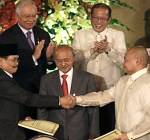Images of brutal violence were at the forefront in the media and in public memory in 2014—which ironically marked a century since World War I was fought ostensibly to end global conflicts.
The proliferation of violence also raises questions about the ability of the United Nations—70 years old in 2015—to meet its mandate of mitigating disputes across the world; the UN has not yet been reformed to address current global challenges.
Even as inter-state wars continue, the last century has also taught the world a lot about peace—primarily through successful non-violent transitions from totalitarian regimes to democracy in Eastern Europe, Latin America, and Asia.
However, in recent years, the same methods seem to have become less effective—in West Asia, for example, violent civil wars have replaced the ‘Arab Spring’. The turmoil has been further complicated by the rise of the militant Islamic State as a direct consequence of the U.S. invasion of Iraq, and constant meddling in the region by other big powers such as UK, France, Saudi Arabia, and Russia. Meanwhile, as the Charlie Hebdo tragedy in Paris shows this week, al-Qaeda has made a comeback driven partly by its competition with the Islamic State.
Many African countries—including South Sudan, Nigeria, and the Democratic Republic of Congo—are grappling with bloody civil wars and uncertain political transitions.
In Europe, diplomacy has been upstaged by the militarisation of U.S. foreign policy, as is evident in the proxy war between the West and Russia in Ukraine.
China has been expanding its influence through infrastructure and aid programmes among smaller African and Asian countries. But the country has also stirred up old—and some imaginary—disputes, and in response to disputed claims over islands with its Asian neighbours, is increasingly exerting its growing military might.
In Pakistan, terrorists and religious extremists continue to wage asymmetric warfare against India. These forces are now a part of Pakistan’s social fabric and endangering its survival as a functional modern state. Afghanistan’s fragile political and security transition is threatened by the violent resurgence of the Taliban.
As we step into 2015, it is important to highlight that violence is not inevitable. Many non-violent movements across the world are growing in success; they are vastly influential and social media has enabled people of diverse views to come together
In the Philippines, Poland, Chile, South Africa and Bolivia, over the past three decades, non-violent movements have led to transitions from dictatorship to democracy. Between 1900 and 2006, of the 25 major resistance movements against repressive regimes, 20 were non-violent—and 70 % of these were successful.
For example, 2014 began with a historic peace agreement between the Moro Islamic Liberation Front and the Philippines government—ending almost 40 years of conflict. An Islamic insurgency has been accommodated rather than obliterated by a Christian majority state through a negotiated settlement.
Similarly, Colombia is negotiating with the FARC (Revolutionary Armed Forces of Columbia) rebels to end 50 years of conflict. This initiative is invigorated by grassroots groups promoting Gandhian concepts of non-violence there and in other Latin American countries.
Closer home, Nepal has peacefully transitioned from a Maoist insurgency against the monarchy to an electoral democracy. While the drafting of the country’s Constitution has been fraught with disagreements, the political reconciliation process involving the Maoists has not collapsed.
Diplomacy and dialogue have so far also averted a larger regional conflagration over the issue of Iran’s nuclear programme. Although a full agreement has not been reached in the stipulated time-frame, the P5+1 and Iran have not abandoned negotiations.
The U.S.-Russia agreement of September 2013 to eliminate chemical weapons in Syria is no small achievement. The stipulated deadlines have largely been met, but the internal strife continues, with terrible consequences for half the population that has been displaced.
Clearly, the global impulse for peace remains strong. With its legacy of a non-violent freedom struggle, how can India contribute to this process in 2015?
In his speech at the UN in September 2014, Prime Minister Narendra Modi spoke of the concept of vasudhaiv kutumbakam—a world-family. This ideal was central to Mahatma Gandhi’s vision of not just a free India, but also a world free of any form of domination and exploitation—this was the basis of true non-violence.
The challenge for Modi is to actualise this ideal—within and outside India.
It can be achieved if India celebrates and reaffirms its inherent cultural and ethnic diversity, and works to strengthen a nation that is free of discrimination. By doing this, India can become a stronger counter-force against the advocates of violence and of a clash of civilizations.
While diplomacy and negotiations must continue to address the flash-points of cross-border warfare, the dramatic rise of the Islamic State has demonstrated that the real contest is not between religions but within, as moderates grapple with fundamentalists in the process of confronting the challenges posed by modernity and globalisation. The fault line is between democracy based on a genuine respect for freedom and diversity versus authoritarian fundamentalism.
We enter 2015 with the hope that the enduring success of non-violent methods in overcoming political disagreements and resolving disputes will expand and pervade the global stage.
Rajni Bakshi is the Gandhi Peace Fellow at Gateway House.
Sameer Patil is Associate Fellow, National Security, Ethnic Conflict and Terrorism, at Gateway House.
This article was exclusively written for Gateway House: Indian Council on Global Relations. You can read more exclusive content here.
For interview requests with the author, or for permission to republish, please contact outreach@gatewayhouse.in.
© Copyright 2015 Gateway House: Indian Council on Global Relations. All rights reserved. Any unauthorized copying or reproduction is strictly prohibited


